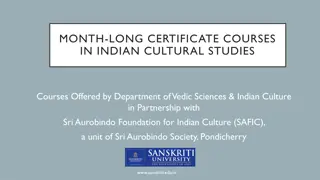Exploring the Rich History of Indian Jewellery Through the National Museum Collection
Uncover the fascinating world of Indian jewellery through the historical artifacts in the National Museum Collection. From ancient adornments dating back almost 3000 years to the exquisite Mughal jewels, discover the evolution of styles, materials, and techniques. Explore the significance of jewellery in ancient art and the cultural influences behind intricate designs. Delve into the craftsmanship of both Northern and Southern jewellers, each showcasing unique traditions and expertise. Join us on a journey through time and culture, where jewels tell captivating stories of civilizations long past.
Download Presentation

Please find below an Image/Link to download the presentation.
The content on the website is provided AS IS for your information and personal use only. It may not be sold, licensed, or shared on other websites without obtaining consent from the author. Download presentation by click this link. If you encounter any issues during the download, it is possible that the publisher has removed the file from their server.
E N D
Presentation Transcript
Alamkara The history of Indian Jewellery through the National Museum Collection
What does Alamkara mean? The term jewel comes from the old French word Joule as something that gives joy. Jewel Everything that gives joy Alamkara is a Sanskrit word that means adornment . What other objects give you joy? A rainbow? Or a soft toy?
Our earliest Jewels Do you know how old our earliest jewels are? Almost 3000 years! This statue is also as old as 3000 years. Information about dancing girl. Importance of jewellary in ancient art. Collection of NM New Delhi
Information about these patterns, material Collection of NM New Delhi Do you think patterns and styles repeat through history?
Ancient Jewelleries from an Ancient Land These jewelleries come from an ancient city of Sirkap, in present day Pakistan. Information about the Greek styles and making techniques. Kings travelling with craftsmen Jewellery identifiers of a civilisation/ dynasty/ region/ time. Collection of NM New Delhi
This is Greece This is Taxila Lets talk about a brave young king, Alexander. Courtesy: www.kingsacademy.com HOW DID THE GREEKS TRAVEL SO FAR?
New Rulers and new jewels The Mughals brought a new aesthetics to Indian Jewellery. Precious gems, gold and diamonds were brought out to make exquisite jewels. Do you know who were the greatest Mughal patrons of jewellery? What are the changes in these jewellery from the earlier ones? Collection of NM New Delhi
Jewellers of the South Jewellers of the North Northern jewellers make jewels through a combination of metals, gemstones and polychrome enamel. Southern Jewellers make jewels through the Repousse technique. Photo to be clicked from gallery Southern jewellery used these gems very often. Do you know where they come from? This is made by a technique called Meenakari. Do you know more about it?
The age of European Jewellery Princely states. Kings travelling abroad. European companies setting base in India. Catering to rich Indian patrons. Image of European Jewellery. Minimal, Statement Jewellary. Courtesy: Pinterest.com
What is jewellery made of? Jewels were a very important part of the human body. Without them, the body was considered imperfect. The earliest jewellery was made of many different materials. Courtesy: wikimedia.org, frontline.org, wired.co.uk Can you think of jewellery made with these?
How are these Jewelleries made? The technique of making jewellery has developed over history. Many techniques have continued unbroken till the present day! Moulds and Dies Repousse / nakshi/ nakashu-velai Filigree and Granulation Minakari and Kundan
Jewellery meets Architecture and sculp This is from a gate of an ancient city of Bharhut. It depicts a creeper that fulfils wishes. Wooden Sculptures/arch. Somebody wished for loads of jewellery. This is from a wall of the Mughal city of Fatehpur Sikri. Why are there so many earrings on it? Do you see them here?
Jewellery meets Art (basholi ) Was jewellery only meant for women? Why was jewellery so important to the ancient people?
Jewellery meets religion Our ancient jewellers took inspiration from the vast collection of mythology to create beautiful motifs in jewels. Jewellery was also a very important part of the idols in temples. Collection of NM New Delhi Did it serve any purpose to put Gods in Jewellery? Or Jewellery in Gods?
Reference List Brijbhushan, Jamila. Masterpieces of Indian Jewellery, D.B. Taraporevala Sons & Co. Private Limited, Bombay, 1979. Kunz, G.F.The curious hore of precious stones, 1913. Col. T.H. Hendley& Lient, Jeypore enamels. Brijbhushan, Jamila. Indian Jewellery Ornaments and Decorative Designs.1964. Nigam. M.L. Indian Jewellery, Tiger books International, London, 1999. Krishnan, Usha .R.Bala and Meera Sushil Kumar. Dance of the peacock: Jewellery Traditions of India, India Book House limited, Mumbai.
Department of Lecturing & Education National Museum new Delhi www.nationalmuseumindia.gov.in Janpath Road www.nationalmuseumindia.gov.in nationalmuseumfacebook.com























